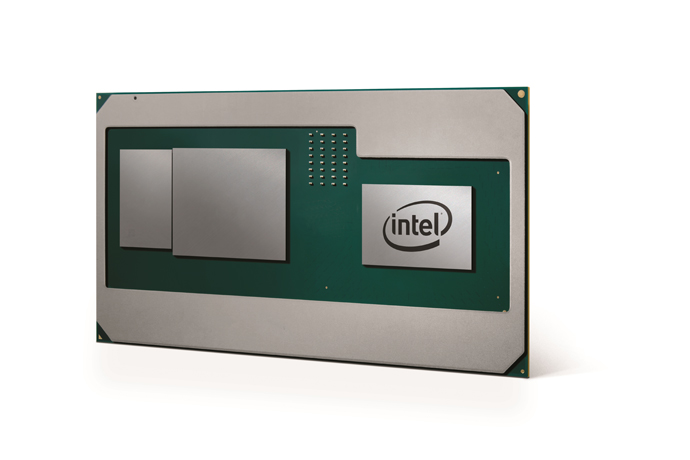Intel and AMD have been dominating the tech news cycle this week. Not only did the two companies announce a collaboration for new Intel laptop processors, but AMD's Radeon Technologies Group head, Raja Koduri, also announced that he would be jumping to Intel to help lead GPU development there. With two of Nvidia's biggest competitors making such huge moves, CEO Jensen Huang couldn't help but share his thoughts on it.
Nvidia held its quarterly earnings report on Thursday night, showing investors results that surpassed expectations. During the call, one financial analyst asked for Huang's opinion on the recent news coming out of AMD and Intel. He first acknowledged that “there's a lot of news out there”, before describing Raja leaving as “a great loss for AMD”.
Image credit: Intel
Huang also described Raja being picked up by Intel as a recognition “that the GPU is just incredibly, incredibly important”. The thing that specifically targets Nvidia, is the idea of Intel producing its own high-end discrete GPUs, moving away from just focusing on integrated graphics solutions.
As Fortune reports, Huang argued that it would take years for Intel to be succeed in bringing a high-end GPU product to market. “It's an enormous undertaking”, he said, adding that it can take around three years to bring a new design to market.
KitGuru Says: It likely will be a few years before we see a high-end GPU from Intel hit the market, whether it's for workstations, AI, servers or gaming. However, when that time does come, it will be interesting to see how this conversation changes.
 KitGuru KitGuru.net – Tech News | Hardware News | Hardware Reviews | IOS | Mobile | Gaming | Graphics Cards
KitGuru KitGuru.net – Tech News | Hardware News | Hardware Reviews | IOS | Mobile | Gaming | Graphics Cards




Intel may be slow, but they’re not stupid. I’m sure they have no intention of trying to build a high-end GPU from scratch. They hired Raja because they are almost certainly going to either buy AMD at some point, or license all the necessary tech from AMD. It’s pretty much impossible to build a high-end GPU at this point without some IP from either nVidia or AMD, and AMD is the more willing partner it seems.
Intel wouldn’t be allowed to buy AMD, they would become the sole manufacturer of x86-64 CPUs and monopolies like that aren’t allowed. They could buy RTG from AMD, though.
Yep, don’t mix ARM and x86-x64 processors, they aren’t the same. Currently, AMD and Intel are the only 2 companies building on the x86-x64 architecture.
Tbh I doubt that AMD would just sell RTG, They would maybe let Intel have 49% of the company, so AMD keeps most of the rights, but Intel is invested enough to put money into R&D.
You say that Intel are not stupid, but look at how their IoT work went. And let’s not forget how they stalled cpu development due to lack of competition.
Plus within a few years all silicon fabs will hit the 7 nm wall which will add just another layer of complexity. Trying to tackle that for cpus and develop a brand new gpu at the same time is going to be carnage.
One word, Ryzen, it’s destroying Intels CPU lead. Time to do a Disney-Pixar deal to stifle the competition. Net result, more over-priced crap from Intel, less undercutting by AMD.
There will be no wall for another 10 years at least. With Intel moving away from their traditional Tick-Tock approach of CPU releases in favour of revisions & refinements on previous architectures like Kaby/Coffeelake is mostly driven by low yields and competition from AMD’s CPU’s and the mobile sector SoCs.
I think they will roll out a few 14nm FinFET CPUs over the next 2 years, then there will be a short stint of 10nm supposedly being called Icelake. The architecture will still continue to shrink and it will be developed in line with Moore’s law, but the roadmaps will slow down on the adaption of these die shrinks. After FinFET (which is actually just 20nm planar process with thinner 3D gates) SiGe will help move it on from 7nm, 5nm 3nm Transistors, only then they will have to consider moving from Silicon maybe to pure Germanium or onto other superconducting possibilities such as Carbon nanotubes/Graphene which is already well under development.
This will certainly be a wall for them to re-develop the techniques/machinery involved for mass production on this atomic scale, therefore I cannot see it happening for at least another 10 years. Although Moore’s law stood well up to now, the further emerging miniaturisation techniques and newly developed superconducting materials will make sure things keep rolling on. As long as there is a demand for these fabs, then they will continue, It’ll just be stretched out a little while longer than usual.
Intel have a backlog of R&D for GPUs which they put on Hiatus, Check out their research on Project Larabee. There’s nothing stopping them from pick this R&D back up and adopting it to the now smaller and more efficient architecture they are now developing. With the insight of AMD on the GPU front. Huang should be very, very wary of this teaming.
Arrr… Ya forgets, there’s still VIA also.
https://uploads.disquscdn.com/images/db200ad2858e88ef8ce6c87371d0e72c4d870a0496bf75d423559270c02763e6.jpg
Arrrr… Intel has some significant share in IoT and embedded largely from their Atom, Apollo Lake and Altera chips. Faster Gemini Lake, Gemini Lake+ and Jasper Lake coming soon….
https://uploads.disquscdn.com/images/b6d812244a1d7bdde0580e80ddc439fed2596a2e16ee1632046d509315997ec9.png
VIA have NEVER been a competitor to Intel. They design CPUs for a specific market segment, and to expect them to take AMD’s place in the event of a buyout is ridiculous. They just couldn’t do it.
Aye! VIA still not good enough to take on both Intel and AMD, but me just showing that theres more than Intel and AMD when talking about x86 chipmakers. VIA has found its niche in China and surrounding regions. There are also others like RDC Semi and DM&P Electronics but they are in embedded sectors only.
Arrr.. Theres another x86-64 chipmaker http://en.zhaoxin.com/Solution.aspx?id=3 the almost forgotten VIA… Ho… Ho….